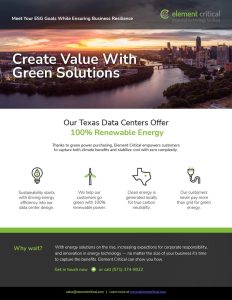Success in 2022 Depends on Environmentally Responsible IT

2021 saw the continuation of significant changes in our lives and commerce as COVID-19 protocols continued to grapple with ways to protect employees from contracting COVID-19 and slow the spread of the virus. In 2019, companies evacuated employees from their offices for the unforeseeable future, spurring a digital transformation to accommodate the new work-from-home world. Meetings and conferences became video calls; in-person events turned into webinars, company celebrations went virtual, too. Datacenter traffic shifted as companies rapidly expanded their footprints to accommodate greater adoption of digitization and data flow. Businesses and consumers alike began to rely more heavily on technology as sales for meal delivery, grocery delivery, education technology, and digital health spiked. Some speculate that this is a permanent change, and consumers will continue to rely more on technology going forward.
Yet, 2021 has been marked by a steep rise in ESG strategies. Social and environmental issues emerged front and center. Paradigm-shifting trials put the world’s eyes on social justice in the U.S., and floods and fires increased in frequency. This year, the Biden administration set a target to achieve a 50-52% reduction from 2005 levels in economy-wide net greenhouse gas pollution by 2030. With the signing of the $1.2 trillion infrastructure bill to support low-carbon technologies, the development of electric vehicles, and environmental remediation.
While DEI (Diversity, Equity, and Inclusion), renewable energy sourcing, and sustainability initiatives have been top-of-mind for companies and organizations for several years, the attention of the media and executive branch combined have made these issues unavoidable for all businesses and investors. Companies that once looked at socially and environmentally responsible activities as side projects or publicity opportunities are now integrating these practices into their day-to-day operations to remain successful.
The Rise of ESG in Investing
ESG (Environmental, Social, and Governance) is a term used to describe a set of factors used to evaluate a company’s level of social and environmental conscientiousness. These factors are an evolution of what was previously referred to as Corporate Social Responsibility or CSR. They include:
- Reducing carbon emissions, waste management, and water management
- Employee diversity and inclusion, supporting human rights and protecting privacy
- Policies against bribery and corruption, diverse board composition, and protection for whistleblowers.
It turns out ESG factors can predict a company’s success or failure. These factors have become increasingly important for investors, and their motives are not purely altruistic. NYU’s Stern Center for Sustainable Business aggregate findings from more than 1,000 research papers that analyzed the relationship between ESG and financial performance. Among other interesting points, they found that:
- Managing a low carbon future improves financial performance.
- ESG investing provides downside protection, especially during a social or economic crisis.
Companies are finding that investing in ESG not only has positive impacts on the environment and their employees; it’s also good for business. A real-life example is Taco Bell’s decision to do away with the Mexican pizza to the chagrin of thousands of die-hard fans. The company announced that this decision would save 7 million pounds of paperboard waste annually.
How Can Data Centers Play A Pivotal Role In Your Businesses ESG Initiatives?
Today, IT leaders face the challenge of ensuring they have substantial compute power and next-generation technology such as data science software and AI to ensure their company can remain competitive. Datacenter footprints will inevitably increase density and will likely become more distributed as businesses accommodate geographically distributed IT environments and support a dispersed workforce. Likewise, consumers and applications require low-latency compute and data storage solutions all the way to the edge.
Companies that rise to the top in 2022 will have transformed their systems to manage data-intensive workloads while minimizing their carbon footprint. Anyone familiar with data centers knows they require energy. Data centers are the industrial-era compute factories of the future. But the good news is that renewable energy is becoming more accessible, and data center providers can fast track ESG initiatives for businesses by supplying data center services that run entirely on renewable resources. It is now possible for companies to plan for a low-carbon future by running their data centers on 100% renewable energy through third-party colocation providers like Element Critical.
Tapping into Renewable Energy in Austin and Houston
Austin and Houston are among the fastest-growing cities in the nation, with companies relocating their headquarters to these areas rapidly since the onset of Covid-19. Texas also leads the nation in wind energy generation, generating 28% of the country’s wind energy in 2020. In 2022, Element Critical will be shifting to accommodate our energy needs and the needs of our customers using renewable energy credits. Our Texas data centers will purchase 100% renewable energy, including delivering on-site solar and sourcing wind and hydropower resources – thereby helping our tenants shrink their carbon footprints.
Click the images below to download the brochure to learn more about our Texas data centers.


